The LRAT 1000/2000 provides a variety of cable test techniques including TDR, wiremapping, office identification, and toning. It is designed to assist in troubleshooting cabling problems, such as excessive cable runs or cables broken at the wall plate or patch panel. The LRAT uses a combination of TDR and resistance measurements to map wires, measure cable length, and identify anomalies, such as shorts, opens, and split pairs. The LRAT does not perform cable certification.
Unexpected Behavior? If you are experiencing unexpected behavior with any of the results below, please follow the instructions at the bottom of this article to re-calibrate your unit.
Locating a Cable with Tone
You can locate cable runs with toning, switch port advertisement, switch port link blinking, and remote wiremap adapters. Toning supports both analog and digital IntelliTone* modes.
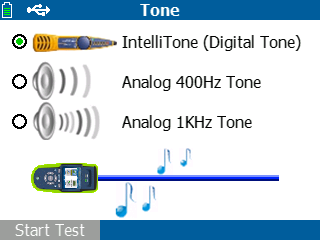
* IntelliTone is a registered trademark of Fluke Networks.
Determining Cable Wiremap and Length
The LRAT can be used to test terminated cables (connected to the internal Wire Mapping Port (WMAP) or an external WireView Cable ID accessory) or unterminated (open) cables.
LRAT can measure accurate length for cables of approximately 300 ft (100 m) or less, with an accuracy of plus or minus 6.56 ft (2 m). LRAT may be able to measure cables up to 500 ft (150 m) with relative accuracy. The minimum cable length is 2.6 ft (0.8 m) for an accurate cable test. For both terminated and unterminated cables, fault detection is also accurate to within a 2.6-ft (0.8-m) distance to the fault.
Length is shown for each pair. In some cases, one pair length might measure as longer than another pair, due to the pair twist rates.
NOTE: LRAT cannot perform a cable test on a cable that is connected to a switch.
Terminated Tests and Results
Using a terminated cable provides the most robust cable measurement results. There are two methods for running a terminated cable test:
1. Terminated at the built-in Wire Mapping Port (WMAP) on your LRAT (bottom left side of the unit)
2. Terminated with a WireView Cable ID Adapter

With a terminated cable test, you can identify the following:
- Cable length
- Normal or negative pair-wise polarity (e.g. pins 1, 2 connected to pins 2, 1)
- Crossover cables
- Shorts
- Opens
- Split pairs
- Reversed pairs
Terminated cable test result types are explained below:
- Good - If the LRAT completes testing and shows the cable pairs and their length, then pin-to-pin wiring matched the expected wiremap configuration from the TIA/EIA‑568 standard. The image below shows a test using the built in WMAP on the LRAT, which has detected a good cable.
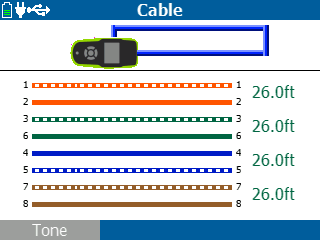
NOTE: In some cases, one pair length might measure as longer than another pair, due to the pair twist rates.
- Crossover - Crossover cables are a common part of Ethernet, and they are defined as normal in the IEEE 802.3 standard. Crossover cables are shown with their crossed pairs and length. The image below shows a test using a WireView/Cable ID #1 that has detected a crossover on pairs 1,2 and 3,6.
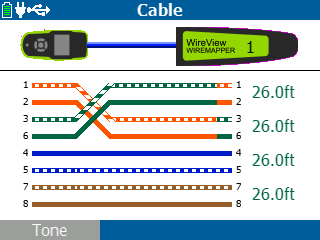
- Open - Opens are determined by wire continuity. An open result indicates that one or both wires in the pair do not have continuity from one end to the other. The length measured for the shorter wire is displayed, and the wire is shown with an open in the middle.
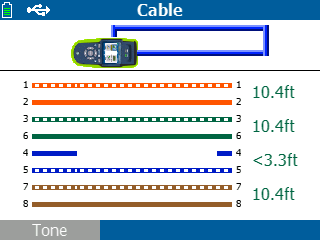
NOTE: If there is more than a 5% difference between the longest pair and the shortest pair, the shorter pair will show as open, even if all pairs are good.
- Short - A short result indicates that there is continuity between two of the wires in the cable. On LRAT, the shorted wires are displayed with a black line connecting them. The image below shows a result with an outer-pair short between pins 2 and 3.
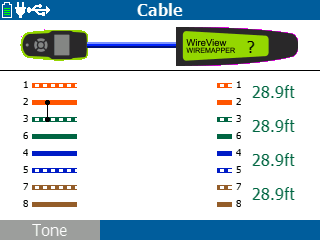
- Split - A split result is displayed whenever the test detects that two wires in a pair were not twisted together for noise immunity for the length of the cable. Due to the nature of split pairs and the detection technique used, the reported length of the pair that is split may not be accurate. The image below shows a split in pins 2 and 3.
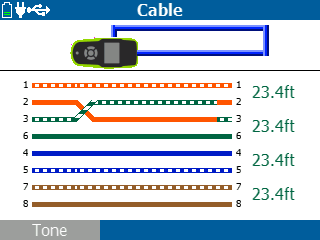
- Reversal - A reversed result occurs whenever continuity testing determines that the first wire in a pair at one end of the cable is found on the second wire in the pair at the other end. For example, from wire pair 1-2 the wire attached to pin position 1 at one end is attached to pin position 2 at the other. This is also known as a tip/ring reversal.
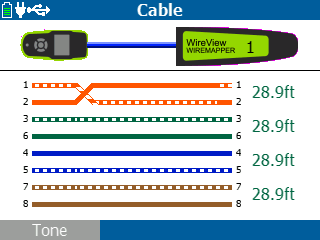
Un-terminated Tests and Results
Using an un-terminated/open cable test you can identify the following:
- Cable length
- Shorts
- Splits
- Opens if they are more than 2 meters from the LRAT
Un-terminated cable test result types are explained below:
- Good: If the LRAT completes testing and shows the cable pairs and their length along with green "Good" text, then pin-to-pin wiring matched the expected wiremap configuration from the TIA/EIA‑568 standard.
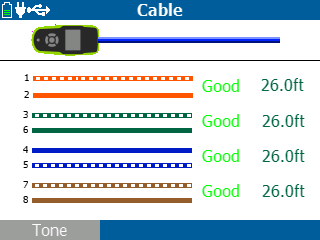
- Shorts are reported equally well in terminated and un-terminated testing. A short result indicates that there is continuity between two of the wires in the cable. An un-terminated cable test displays red "Short" text next to the shorted wires. The image below shows an inter-pin short between 1 and 2.
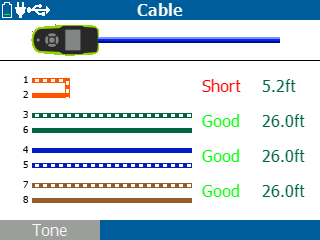
- Split pairs are reported if the cable is at least 2.6 ft (0.8 m) long. A split result is displayed whenever the test infers the presence of two wires in a pair were not twisted together for noise immunity for the length of the cable. An un-terminated cable test displays red "Split" text next to the split pairs. Due to the nature of split pairs and the detection technique used, the reported length of the pair that is split may not be accurate.
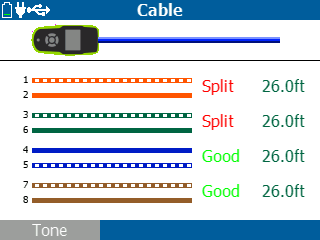
If a shorter cable is reported to have two pairs that are longer (and approximately equal in length) than the other two (that are also approximately equal in length), a split pair could possibly be the cause, though a split will not be reported.
- Open - Opens are determined by wire continuity. An open result indicates that one or both wires in the pair do not have continuity from one end to the other. An un-terminated cable test displays red "Open" text next to the open pairs.
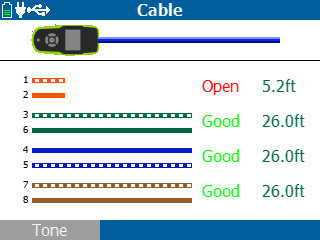
NOTE: Open/un-terminated cables with crossovers will display as "good" because LRAT cannot detect crossovers in un-terminated cables.
Calibrating the LRAT Cable Test
If your LRAT is showing a crossed pair or a different Wireview than expected, the unit might have lost its calibration settings. This can easily be remedied by the following procedure:
- You will need a known good, straight cable of about a meter's length.
- Power your LRAT on (without any cables connected).
- From the Home screen, select Cable.
The cable test will fail because there is no cable connected. - When it fails, press the Left Arrow, Right Arrow, and Select button simultaneously.
- You should now see a Cable Calibration screen. Connect the known good cable between the LAN port up top and the Wiremap port (bottom left).
- Press Calibrate (F1).
















